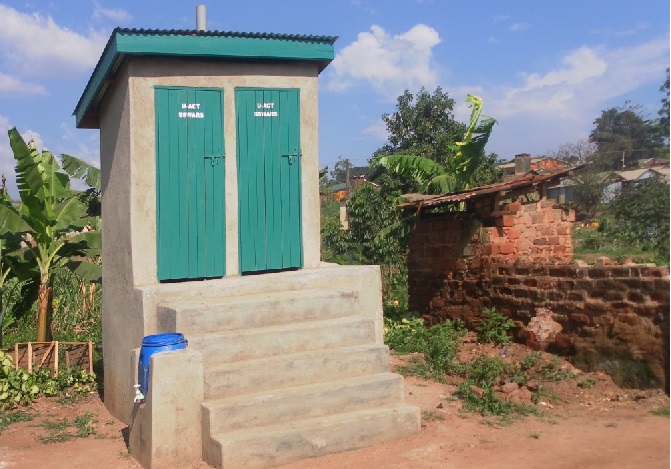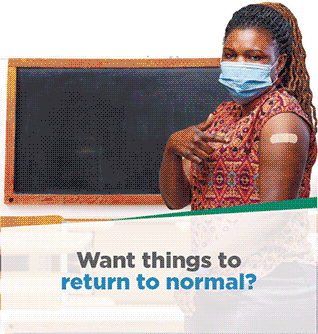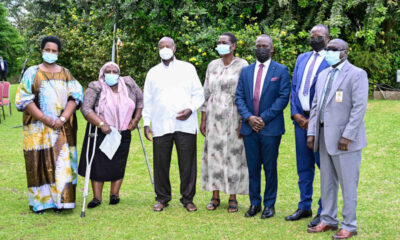Health
High construction costs holding back toilet coverage

Improved Latrines like this one are expensive to construct by ordinary low income earners in Uganda
Around 3.6 billion people worldwide live without a toilet or a latrine which is a health hazard.
Without proper sanitation facilities, waste from infected individuals can contaminate a community’s land and water, increasing the risk of infection for other individuals.
A 2019 report conducted by Twaweza’s Sauti za Wanaichi on citizens views and experience on situation and hygiene in Uganda indicates that the most widely form of toilet in Uganda is a pit latrine, at 66% followed by ventilated Pit latrine at 15% and pit latrines without a slab at 15%, the flash toilets are used by small minority which is1% even in the urban areas the figure stands at only 3% among wealthier Households still at 3%.
Statistics further show 3 out of 10 households which is 30% share their toilet facility with people who are not members of their households. This figure is high in urban areas standing at 41% and among those who use ventilated pit latrines standing at 39%.
Now ahead of the 2021 World Toilet Day commemorations slated for 19th November, under the theme “valuing toilets”, Solomon Lubambula visited Namutumba District to assess the toilet coverage in the district.
“Our biggest challenge in this village is the absence of latrines; you may find only two latrines in 10 homes” was James Mwanje’s opening statement when I asked him in an interview to comment about the toilet coverage in his area.
Mwanje who is a resident of Kayiti Village in Namutumba District is concerned that sanitation remains a huge challenge in the entire Namutumba District with only 30% of the households with unimproved toilet facilities while the rest of the households completely have no toilet facilities.
“In a year you may dig three pit latrines because of the nature of our soil type which is sand. Government has not sensitized people about the right way of constructing latrines. We have government health inspectors but they don’t seem to care. Now the rain season has come and some of the latrines are on the verge of collapse which will likely expose us to cholera. We feared COVID, but instead of that, cholera might be our undoing”-Mwanje.
As Mwanje attributes the problem of having no toilet facilities partially to the district leaders, Florence Mwine a resident of Kayiti Village says the nature of the soil in the area makes it hard for people to dig pit latrines especially in the rainy season.
“The biggest problem we have here concerning building latrines is the bad soil. Most of our soil is sandy as you can see, which is why we request the government to work with us on this”-Mwine noted.
Reluctance in health inspection and the soil type are not the only factors affecting toilet coverage.
Constructing a standard pit latrine comes with financial costs yet the majority of the population cannot afford the expenses to dig and put up pit latrines/toilets. Considering the expenses involved coupled with the financial challenges among many households, some suggest the government should intervene.
“We implore the government to come up with a program to help us with this. Take for example; two latrines are enough for our village. We are very close to the town council and the other could be put in the sub county. People can use those in the meantime”- Mwanje.
Whereas some accuse local leaders of not being so helpful in terms of sensitizing the community, according to the Namutumba District Information Officer Noah Kiira the local government has tried to do its part but the problem goes deeper than that, to him it’s a mindset problem that sensitization alone cannot fix.
“I have to inform everybody within Namutumba District that these rains have come as a blessing and as a challenge as well, putting emphasis on water and sanitation we must ensure that we all have toilet facilities in our homes to avoid suffering from a number of diseases including cholera and typhoid”-Kiira stressed.
Still the Chairman LC V Namutumba District, David Mukisa disclosed that there is a pending project that focuses at encouraging households to have pit latrines and toilets, as a move to promote sanitation and hygiene.
“Right now the plan is sensitization and awakening people to build latrines. We received a little money for sensitization to guide people on household health…as a precondition for building boreholes in the villages, households must have latrines and if they don’t then they don’t get access to water. The role of VHTs is to sensitize residents on the purpose of latrines and hygiene, the lack of which exposes them to diseases like cholera”-Mukisa
Village Health Teams (VHTs) have a big role to play if matters of sanitation are to be enhanced in the community. Mukisa appeals to Village Health Teams to boost their efforts in sensitizing the locals about the importance of having toilets/pit latrines.
“… Wherever you are, let’s sensitize people so that they stay alive because only the living can vote for us… I just pray that we continue to stay safe from every disease. Let’s work hard and prosper”-Mukisa
On a whole the efforts of local government, NGOs and other parties will only make sense, when the ordinary people appreciate that it is their lives and that of their loved ones at risk if they do not have toilets.
“Yes we have covid19, but just know that there are other diseases which are common during the rainy season. So when you do not have a latrine, there are diseases that are going to attack you so we are requesting everybody to construct a pit latrine so that they can be safe”-Mukisa concluded.
Comments



















